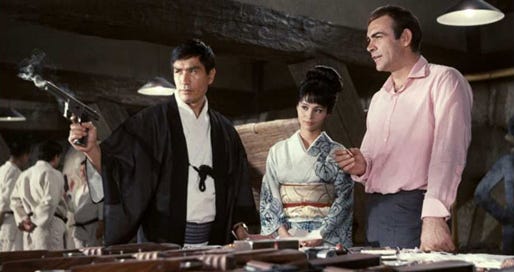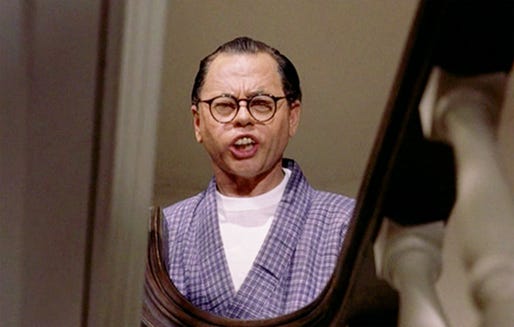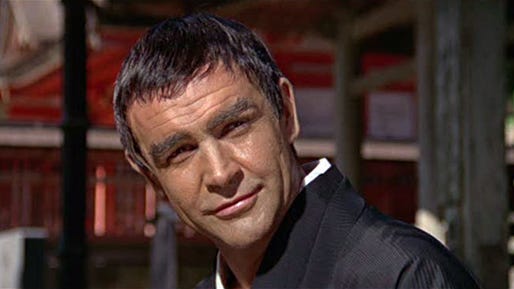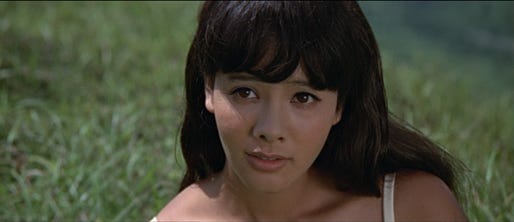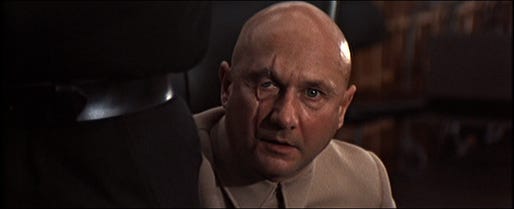You Only Live Twenty-Thrice: "You Only Live Twice"
“You Only Live Twenty-Thrice” is a look back at the James Bond films.
Each Friday until the release of the 23rd official Bond film, “Skyfall,” we will revisit its 22 official predecessors from start to finish, with a bonus post for the unofficial films in which James Bond also appears.
In 1967’s “You Only Live Twice,” James Bond must stop a madman on a mysteriously hidden Japanese island, who conspires to start World War III by fiddling with several nations’ space programs.
On paper, that sounds like little more than a lazily derivative transplant of “Dr. No” from the Caribbean to the Pacific Rim and a floundering follow-up to 1965’s canned and constrained “Thunderball.”
Instead, “Twice” rights Bond’s ship with imaginative storytelling, impeccable production design and furious filmmaking flourishes that bury the needle on coolness. The film flirts with science-fiction, suffuses itself with subtext, floats by on the swoon-worthy lilt of the late John Barry’s most beautiful Bond score and finally puts a horrifying face to Bond’s nemesis, SPECTRE head Ernst Stavro Blofeld.
It’s also a nice break from the Caribbean-European seesaw of settings for the four previous Bond films, as it’s set almost entirely in Japan. “Twice” is restricted to one location, but it’s anything but restrained. Here is the most unchained, expansive and exciting Bond adventure yet — with a moment of Bond soaring over the tree line in a well-armed gyrocopter that feels like the series’ ascension to the cruising altitude of jaw-dropping spectacle.
Longtime series editor Peter Hunt left an immortally influential mark on action cinema with how he cut the first four films together. (For a fascinating, in-depth read on Hunt’s pioneering techniques, check out the Bond blog Dr. Shatterhand’s Botanical Garden.)
As second-unit director here in charge of the action sequences, Hunt left a similarly legendary stamp, as “Twice” introduces impressive stunt work and a truly stunning scope of big-ticket practical effects to the Bond series. Watch as the camera goes wide on the rooftop fight to sell its height and scope before Bond jumps a long way down to save himself.
Hunt is also said to have salvaged “Twice” after director Lewis Gilbert’s usual editor delivered a disastrously received initial cut. For his skills, Hunt was given directorial reins for “On Her Majesty’s Secret Service,” but he wouldn’t get to direct Sean Connery.
Increasingly frustrated by a rigorous schedule of production and promotion and afraid of typecasting, Connery announced his departure from the Bond role during “Twice’s” filming. Perhaps Connery also felt his work cheapened by a flood of cut-rate spy movies — with no fewer than 22 such films released a year before “Twice.”
Appropriate, then, for a franchise unwilling to be lumped in with others that the Bond theme is in a distinctively different key before an outer-space prologue. When an American spacecraft is swallowed up by what looks like a bird of prey’s beak, the Soviets are accused of sabotage. When the Russkies verbally fire back, Great Britain is brought to mediate after sources suggest the offending craft was somehow launched from Japan … and they have just the man to investigate.
Too bad 007 is dead at a gunman’s hands. Or at least that’s what we’re led to believe before a title-credits sequence of beautiful volcanic eruptions and silhouetted Japanese women kneeling in seemingly sexual supplication to Bond.
A side note: Save the enduring “James Bond Theme,” no Bond fanfare is as immediately inductive of goosebumps as the romantic introduction to "You Only Live Twice," the song. It’s sung sufficiently, if dispassionately, by Nancy Sinatra in a version reportedly cobbled together from more than two dozen takes. Years later, Icelandic singer Bjork recorded a cover — no less lustrous, but with far more fervor.
Of course, Bond isn’t dead … but what if he’s not quite the same Bond we’ve come to know? As divers recover a body at sea, the mind reels with what crazy solution the movie could concoct. Has Bond been cloned? Did MI6 use the same face-doubling technology SPECTRE used on Mr. Angelo in “Thunderball”? The solution is the first of “Twice’s” many thrills — a faked death to throw SPECTRE off Bond’s trail.
M and Moneypenny then brief Bond for his mission, their offices amusingly re-created aboard a British sub. It’s here that Lois Maxwell truly solidifies her always formidable presence as Moneypenny — good for a chastely comic, if suggestive, interlude with James, but also a bit melancholy about their coulda woulda shoulda.
Maxwell took the role because her husband had suffered a heart attack, and they needed the money to pay for his care. Even if her total minutes of screen time barely exceeded the total of years she held the role — 23 — Maxwell was always a formidable presence for James. That’s because Moneypenny is neither a mere office flirt nor a whiny unrequited lover. She’s symbolic of the smart, supportive and self-reliant woman who could await James were he to ever settle down.
James and Moneypenny have been physically close before in the Connery Bonds, but “Twice” gives them a scene of weighty intimacy. The password James is to utter to his Japanese Secret Service contacts upon arrival is “I love you.” Moneypenny tells him this and then asks him to repeat it. After a beat, he says he can remember it, and the adventure carries on. It’s an astoundingly well-thought-out set-up to a shared moment in “On Her Majesty’s Secret Service.”
Bond’s faked death is a perfect narrative gambit to send him somewhere completely foreign. Japan is a nation with sites both bustlingly urban and beautifully pastoral, so utterly and sweepingly cinematic as to be enough location for one movie.
Just like his series of films, the sumo tournament at which Bond meets partner agent Aki (Akiko Wakabayashi) is a blend of elegance, tradition, violence and honor. The modular furniture (that gets destroyed) in duplicitous businessman Osato’s office is a beauty to behold. And “Twice” is a true travelogue through Tokyo and beyond, its itinerary built on the ingenuity of Ken Adam and Freddie Young — the former a Bond staple as production designer and the latter a Bond newbie with two Oscars under his belt.
In a movie where gadgetry abounds, the duo still abides by a Taoist aesthetic of emptiness — that mood should be captured more by imagination, less by what you can physically see. Even Blofeld’s vast volcano base, where Bond’s trail inevitably leads, abides by that principle. Yes, Adam has designed a believable, practical monorail. But Young films it mysteriously, as to hint at the unseen inner nooks and crannies where it might stop.
It wouldn’t be 1960s Bond, though, without crass exploitations of foreign culture. It’s never been easier for Bond to get laid than it is for him in Japan — between the easily pliable Aki, villainous Helga Brandt (Karin Dor, a redhead who pales in malice beside Luciana Paluzzi’s Fiona Volpe) and subservient, ’60s-bombshell geishas introduced by Tanaka (Tetsurō Tamba), supervisor of the Japanese secret service.
Plus, the double entendres have never been cheekier: “In Japan, men come first and women come second,” Tanaka quips. Bond remarks he likes the Japanese “plumbing” and the “different taste” of their women. Aki tells Bond she’ll “very much enjoy serving under” him. And even Brandt juts out her breasts like bazookas as she says, “Mr. Osato believes in a healthy chest.”
If “Twice” has any fault, it’s that it’s the most overtly misogynist Bond movie Connery ever made — seeing as how two Bond girls, including the resourceful Aki, die long before the climactic battle.
At least Aki saves Bond’s bacon at a crucial moment outside Osato’s office, leading to a car-versus-helicopter chase that’s majestically shot amid a mountainous backdrop and fraught with suspense. (To whom does that helicopter belong? Even despite the phone call, we’re not initially sure.) Christopher Nolan might have paid loving homage to the alpine ski-slope chase in “On Her Majesty’s Secret Service” when he made “Inception.” But look at the framing and resolution of this chase, and you can see Nolan’s affection for mega-budgeted, realistic hugeness was born right here.
It’s not the only aerial marvel in “Twice,” as Bond takes to the skies in “Little Nellie,” a gyrocopter outfitted by Q with flamethrowers, bullets, rockets, missiles, mines, smoke and cameras — with switches amusingly marked with the embossed plastic of a label maker.
After this sequence, “Twice” goes quiet for a time but loses none of its momentum. To further immerse himself undercover and infiltrate Blofeld’s lair, Bond undergoes a transformation into a “Japanese” fisherman. In the 1960s, such makeup either meant this …
… or this.
It’s patently ridiculous, but even though he was leaving, producers weren’t going to cover up their star’s face. Even that getup doesn’t foil a failed attempt on Bond’s life, so he further sells the lie by agreeing to marry Tanaka’s student, Kissy Suzuki (Mie Hama). Tanaka tells Bond that Kissy has “the face of a horse,” which worries him ridiculously. But naturally, she’s a knockout, which gets Bond thinking about honeymoon duties sooner rather than later.
That said, “Twice” doesn’t have to pause for their marriage ceremony, but it’s wise to do so. Façade or not, it binds Bond to a woman willingly offering her assistive services under the guise of marriage. It’s yet another plot point foreshadowing “On Her Majesty’s Secret Service” and an honorable moment to temper the misogyny.
Gilbert ratchets up the action for a climactic confrontation inside Blofeld’s lair. The funny thing is that “Twice” is more than half-over before Bond truly discovers Blofeld’s involvement, but that doesn’t make Blofeld’s provocation toward global apocalypse less palpable. He pushes the world to an irrefutably nuclear brink before his plot is foiled, and Pleasance, easily the least physically fearsome of the official Blofelds, offers the character’s definitive portrayal in five minutes of screen time.
When Blofeld whirls around to reveal his long, jagged, disfiguring scar — allegedly Pleasance’s idea — it says everything we need to know about this man: He survived whatever caused that, so he can endure pain and dish it out.
The final swarm on Blofeld’s stronghold is a full-scale assault — a free-for-all in which rappelling ninjas come to Bond’s aid. It’s so explosive that Blofeld’s beloved cat seems poised to use up every one of its remaining lives.
Connery would later officially return once more for 1971’s “Diamonds Are Forever.” But “Twice” ended his tenure at the time with panache and propulsive energy … and not a little bit of screw-it-and-see-what-sticks storytelling.
Next week: "On Her Majesty's Secret Service"
BULLET POINTS
Surprisingly, Kissy Suzuki’s name is never mentioned in the film. It’s always been assumed that’s the character’s name because it’s Mie Hama’s character’s name in the source novel.
“You Only Live Twice” was the first James Bond film with a premiere attended by Queen Elizabeth II.
Ernst Stavro Blofeld’s base was a fully operative set at Pinewood Studios, so tall it was visible from three miles away and fitted with a monorail, elevators, a heliport, a rocket that rose 50 feet and a price tag of, cue your pinkie finger, one million dollars.
During pre-production, director Lewis Gilbert, producers Albert R. “Cubby” Broccoli and Harry Saltzman, production designer Ken Adam and director of photography Freddie Young went location scouting in Japan. They bailed on a flight back to the UK in favor of watching a ninja demonstration — a flight that crashed and killed everyone onboard.
Aerial cameraman John Jordan wouldn’t be so lucky. While filming the helicopter battle, Jordan leaned out of his bird to get a better shot. An updraft hit, sending the helicopter below toward Jordan’s, and nearly severing his leg with one of its rotor blades. Doctors saved Jordan’s leg then, but it was later removed, and he returned (with an artificial leg) to hang 18 feet below choppers in an apparatus to film “On Her Majesty’s Secret Service.” Never one to wear a safety harness, and moving slower because of his artificial leg, Jordan was fatally sucked out of an open doorway into the Gulf of Mexico while filming “Catch-22” in 1969.

